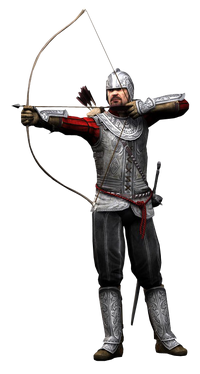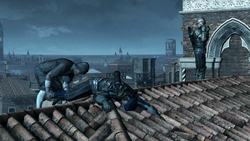No edit summary |
(Thumb-nailing.) |
||
| Line 1: | Line 1: | ||
{{Era|AC|ACBL|AC2|AC2D|ACB|PL}} |
{{Era|AC|ACBL|AC2|AC2D|ACB|PL}} |
||
| − | [[File:Guard-archer-AC2.png|right|200px]] |
+ | [[File:Guard-archer-AC2.png|right|200px|thumb|An archer.]] |
'''Archers''' were [[guards]] armed with [[Bow|longbows]], who patrolled rooftops and watched for possible enemies below. They usually initiated attacks against any intruder they noticed above ground. A well placed arrow could knock down an assassin from a rooftop. |
'''Archers''' were [[guards]] armed with [[Bow|longbows]], who patrolled rooftops and watched for possible enemies below. They usually initiated attacks against any intruder they noticed above ground. A well placed arrow could knock down an assassin from a rooftop. |
||
Revision as of 18:07, 2 March 2013

An archer.
Archers were guards armed with longbows, who patrolled rooftops and watched for possible enemies below. They usually initiated attacks against any intruder they noticed above ground. A well placed arrow could knock down an assassin from a rooftop.
Once provoked by an enemy approaching within a meter or so, an archer would cease firing arrows, and draw his sword or mace. Though accurate and deadly from a distance, archers did not pose a serious threat in close combat.
However, large groups of archers were capable of holding off an Assassin, with some attacking from close-range, and others from a distance.
History
High Middle Ages

Altaïr throwing a knife at an archer in Acre.
Archers were stationed on the rooftops of every city, and on top of large wooden watch towers in the Kingdom. They usually guarded important areas or people, and strictly enforced the city's laws against civilians being up on the rooftops. The Templar Talal was also particularly skilled in archery, and had his own contingent of archers as his personal guard.[1]
Templar archers were not as hostile as those in Acre, Jerusalem or Damascus, and would usually only provoke a fight if the Assassin had already been exposed, and was being pursued.[2]
Renaissance

Antonio de Magianis' thieves replacing Emilio Barbarigo's archers.
Archers took advantage of two varieties of ammunition within the Renaissance: ordinary arrows, and fire-tipped ones. Though the former was widely used, the latter was only notably used in three instances: attacking the horse-drawn carriage of Ezio Auditore da Firenze and Leonardo da Vinci in the Appennine Mountains, shooting down the Flying Machine both as Ezio infiltrated the Palazzo Ducale,[3] and during the Battle for Forlì.[4] Aside from attacking passing Assassins, archers also hunted down pickpockets or Borgia Messengers, should they cross their patrol.[3]
In Rome, crossbowmen and arquebusiers, each with superior weaponry, largely replaced and took on the role of archers. However, unlike archers, they did not possess a close combat weapon alongside their crossbows or firearms. Instead, they would use their weapon to parry blows, or keep their distance to continue firing. Archers could only be found guarding the Borgia War Machines; attacking the stolen Machine Gun from rooftops, the Naval Cannon from aboard ships, and the Bomber from archer towers.[5]
Upon building his own guild of Assassins, Ezio trained each of his apprentices in archery. Upon his signal, a group of them could fire a flurry of arrows at an indicated target, and this action was often referred to as an "Arrow Storm."[5]
Trivia
- In Assassin's Creed, archers of Acre were the only guards that wear hoods.
- In Assassin's Creed II, two variations of archers could be found in assassination missions: Elite archers and Captain archers, each with trademark headgear and fighting capabilities.
- Captain archers were seen in the memories "Honorable Thief" and "Everything Must Go;" although the archers in the latter were actually thieves wearing the customary head wraps.
- During the Bonfire of the Vanities, Girolamo Savonarola's lieutenant, the Captain Guard, made use of multiple archers, alongside Agile guards, to form a deadly ambush.
References
- ↑ Assassin's Creed
- ↑ Assassin's Creed: Bloodlines
- ↑ 3.0 3.1 Assassin's Creed II
- ↑ Assassin's Creed II - Battle of Forlì (DLC)
- ↑ 5.0 5.1 Assassin's Creed: Brotherhood
| ||||||||||||||||||||||||||||
| ||||||||||||||||||||||||||||
| ||||||||||||||||||||||||||||
| |||||||||||||||||||||||||||||||||||||
| ||||||||||||||||||||||||||||||||||
